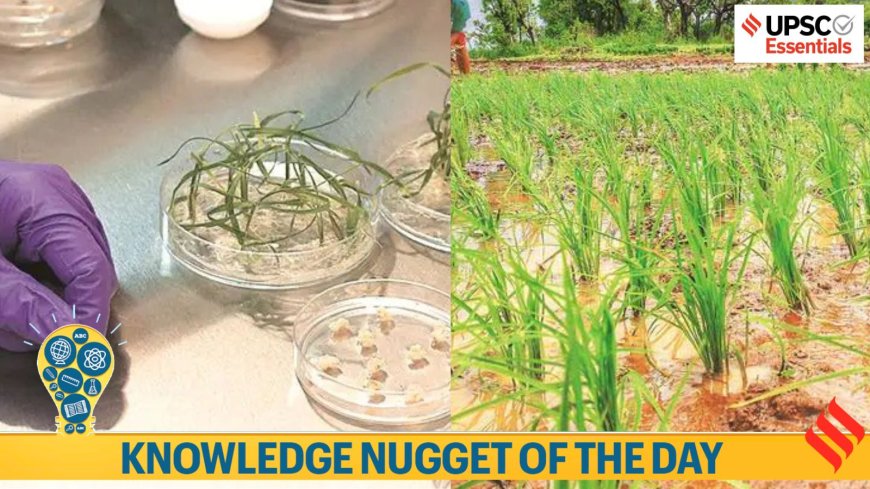Knowledge Nugget: What to know about gene editing for UPSC as world’s first GE rice varieties make headlines

Asarkari - Sarkari News, Jobs & Updates
Knowledge Nugget: What to know about gene editing for UPSC as world’s first GE rice varieties make headlines
By Priya Sharma
In a world grappling with food security challenges and the persistent burden of genetic diseases, scientific breakthroughs offer rays of hope. Recently, the development of the world’s first gene-edited (GE) rice varieties has captured global attention, signaling a new era in agricultural biotechnology. For aspirants preparing for the UPSC Civil Services Examination, understanding the nuances of gene editing, its applications, ethical implications, and India's stance is crucial, as it frequently features in the Science and Technology, and Environment sections of the syllabus.
Understanding Gene Editing: The Basics
Gene editing, at its core, is a group of technologies that give scientists the ability to change an organism's DNA. This can involve adding, removing, or altering genetic material at particular locations in the genome. Think of it as a highly precise "find and replace" tool for the genetic code. Among the various gene-editing tools, CRISPR-Cas9 (Clustered Regularly Interspaced Short Palindromic Repeats and CRISPR-associated protein 9) has emerged as a revolutionary technique due to its efficiency, cost-effectiveness, and ease of use compared to older methods.
CRISPR-Cas9 works like a pair of molecular scissors guided to a specific DNA sequence by a guide RNA (gRNA). Once the target DNA is found, the Cas9 enzyme cuts the DNA, allowing scientists to then delete genes, insert new genetic material, or modify existing sequences. This precision distinguishes gene editing from earlier genetic modification techniques, which often involved random insertion of genes.
GE Rice: A New Dawn for Agriculture?
The news about the world's first gene-edited rice varieties making headlines underscores the immense potential of this technology in agriculture. These GE rice strains are often engineered for desirable traits such as increased yield, enhanced nutritional value (like higher vitamin content), improved resistance to pests and diseases, and greater tolerance to environmental stresses like drought or salinity.
For instance, some gene-edited rice varieties might require less water or fewer pesticides, contributing to more sustainable farming practices. This is particularly significant for countries like India, where rice is a staple crop, and agriculture faces numerous challenges. The success of GE rice could pave the way for similar advancements in other essential food crops, bolstering global food security and reducing the environmental footprint of agriculture. The ability to precisely tweak genes responsible for these traits without introducing foreign DNA (in some cases, like SDN1 and SDN2 categories of gene editing) also makes them potentially more acceptable to regulators and consumers compared to traditional Genetically Modified Organisms (GMOs).
Vast Applications Beyond the Paddy Field
While GE rice highlights agricultural applications, the scope of gene editing extends far beyond. Its potential impact on human health is profound.
Medicine and Therapeutics: Gene editing holds promise for treating a wide range of genetic disorders. Somatic cell gene therapy, which involves editing the genes in a patient's body cells (non-reproductive cells), is being explored for conditions like sickle cell anemia, cystic fibrosis, Huntington's disease, and certain types of cancer. Researchers are also working on using gene editing to enhance the immune system's ability to fight infections or cancer (e.g., CAR T-cell therapy).
Diagnostics and Research: Gene editing tools are invaluable in research for understanding gene function and disease mechanisms. They can be used to create disease models in cells or animals, accelerating the development of new drugs and diagnostic tools.
Industrial Biotechnology: In industry, gene editing can be used to engineer microorganisms like bacteria and yeast to produce biofuels, pharmaceuticals, enzymes, and other valuable biochemicals more efficiently.
The Ethical Maze and Regulatory Hurdles: A UPSC Focus
Despite its transformative potential, gene editing raises significant ethical, social, and regulatory questions, which are critical areas for UPSC aspirants to analyze.
Ethical Concerns:
- Off-target effects: The "molecular scissors" can sometimes cut at unintended sites in the genome, leading to unforeseen consequences.
- Germline editing: Editing genes in sperm, eggs, or embryos (germline cells) would result in changes that are heritable, passed down to future generations. This raises concerns about "designer babies," altering the human gene pool, and the potential for unforeseen long-term effects. Most countries, including India, currently prohibit or strictly regulate germline editing.
- Somatic cell editing: While considered less controversial as changes are not inherited, issues of safety, efficacy, and informed consent for patients remain paramount.
- Accessibility and Equity: High costs associated with gene therapies could exacerbate existing health inequalities, making these treatments available only to the wealthy.
Social and Environmental Impact:
- Biodiversity: Widespread use of specific gene-edited crops could potentially reduce agricultural biodiversity if not managed carefully.
- Public Perception: Public understanding and acceptance of gene-edited products are crucial. Misinformation and lack of transparency can lead to public resistance.
Regulatory Landscape: Governments worldwide are grappling with how to regulate gene-edited organisms. A key debate is whether products of gene editing, especially those without foreign DNA (like SDN1 edits), should be regulated as strictly as traditional GMOs. The European Union has generally taken a stringent approach, while countries like the USA, Argentina, and Japan have more lenient regulations for certain types of gene-edited products. India is also evolving its regulatory framework, aiming to balance innovation with safety. For more updates, visit https://asarkari.com.
India's Position and Future Prospects
India has a cautious yet progressive approach towards gene editing. The Department of Biotechnology (DBT) and the Genetic Engineering Appraisal Committee (GEAC) under the Ministry of Environment, Forest and Climate Change are the key regulatory bodies. In 2022, the MoEFCC exempted certain types of gene-edited plants falling under SDN1 and SDN2 categories from stringent GMO regulations, provided they are devoid of any foreign DNA. This move is expected to accelerate research and development of improved crop varieties in India.
Indian research institutions are actively engaged in gene editing research for crops like rice, wheat, mustard, and banana to improve traits like yield, nutritional quality, and stress tolerance. The potential benefits for Indian agriculture and healthcare are immense, from developing climate-resilient crops to finding cures for genetic diseases prevalent in the Indian population. However, robust oversight, continued public discourse, and capacity building are essential to harness this technology responsibly.
Conclusion: A Double-Edged Sword for a Brighter Future?
Gene editing is undeniably one of the most powerful scientific tools developed in recent times. From revolutionizing agriculture with crops like GE rice to offering potential cures for debilitating genetic diseases, its promise is vast. However, this power comes with profound ethical responsibilities and complex regulatory challenges.
For UPSC aspirants, a comprehensive understanding of gene editing – its scientific basis, diverse applications, the socio-ethical concerns it engenders, and the evolving global and Indian regulatory frameworks – is indispensable. It's a topic that sits at the intersection of science, ethics, policy, and society, making it a prime candidate for questions in both Prelims and Mains. As the technology continues to evolve, staying updated with developments like the GE rice breakthrough will be key to navigating its complexities and appreciating its potential to shape our future.
kam sabdo me kahein to, gene editing offers precise DNA modification with vast potential in agriculture, like new GE rice, and medicine, but raises significant ethical and regulatory questions crucial for UPSC aspirants to understand.
Written by Priya Sharma
Team Asarkari
Keywords
gene editing, CRISPR Cas9, UPSC science and technology, GE rice, genetically engineered crops, agricultural biotechnology, bioethics, Indian agriculture policy, genetic disorders treatment, food security, biotechnology regulation India, SDN1 SDN2 gene editingWhat's Your Reaction?
 Like
0
Like
0
 Dislike
0
Dislike
0
 Love
0
Love
0
 Funny
0
Funny
0
 Angry
0
Angry
0
 Sad
0
Sad
0
 Wow
0
Wow
0









































